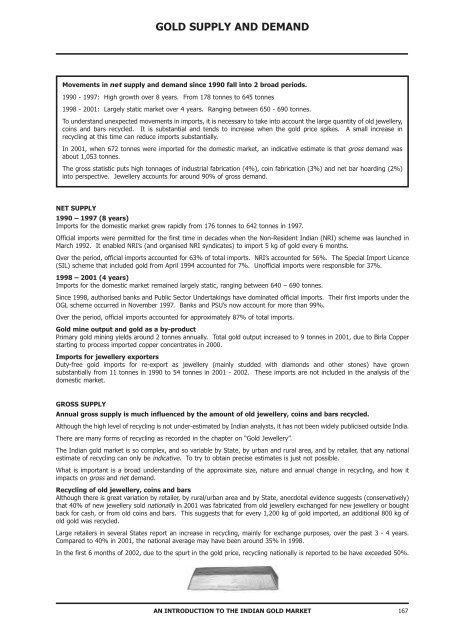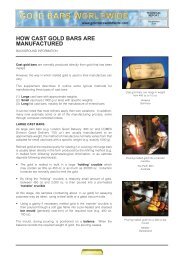Indian Gold Book:Indian Gold Book - Gold Bars Worldwide
Indian Gold Book:Indian Gold Book - Gold Bars Worldwide
Indian Gold Book:Indian Gold Book - Gold Bars Worldwide
You also want an ePaper? Increase the reach of your titles
YUMPU automatically turns print PDFs into web optimized ePapers that Google loves.
GOLD SUPPLY AND DEMAND<br />
Movements in net supply and demand since 1990 fall into 2 broad periods.<br />
1990 - 1997: High growth over 8 years. From 178 tonnes to 645 tonnes<br />
1998 - 2001: Largely static market over 4 years. Ranging between 650 - 690 tonnes.<br />
To understand unexpected movements in imports, it is necessary to take into account the large quantity of old jewellery,<br />
coins and bars recycled. It is substantial and tends to increase when the gold price spikes. A small increase in<br />
recycling at this time can reduce imports substantially.<br />
In 2001, when 672 tonnes were imported for the domestic market, an indicative estimate is that gross demand was<br />
about 1,053 tonnes.<br />
The gross statistic puts high tonnages of industrial fabrication (4%), coin fabrication (3%) and net bar hoarding (2%)<br />
into perspective. Jewellery accounts for around 90% of gross demand.<br />
NET SUPPLY<br />
1990 – 1997 (8 years)<br />
Imports for the domestic market grew rapidly from 176 tonnes to 642 tonnes in 1997.<br />
Official imports were permitted for the first time in decades when the Non-Resident <strong>Indian</strong> (NRI) scheme was launched in<br />
March 1992. It enabled NRI’s (and organised NRI syndicates) to import 5 kg of gold every 6 months.<br />
Over the period, official imports accounted for 63% of total imports. NRI’s accounted for 56%. The Special Import Licence<br />
(SIL) scheme that included gold from April 1994 accounted for 7%. Unofficial imports were responsible for 37%.<br />
1998 – 2001 (4 years)<br />
Imports for the domestic market remained largely static, ranging between 640 – 690 tonnes.<br />
Since 1998, authorised banks and Public Sector Undertakings have dominated official imports. Their first imports under the<br />
OGL scheme occurred in November 1997. Banks and PSU’s now account for more than 99%.<br />
Over the period, official imports accounted for approximately 87% of total imports.<br />
<strong>Gold</strong> mine output and gold as a by-product<br />
Primary gold mining yields around 2 tonnes annually. Total gold output increased to 9 tonnes in 2001, due to Birla Copper<br />
starting to process imported copper concentrates in 2000.<br />
Imports for jewellery exporters<br />
Duty-free gold imports for re-export as jewellery (mainly studded with diamonds and other stones) have grown<br />
substantially from 11 tonnes in 1990 to 54 tonnes in 2001 - 2002. These imports are not included in the analysis of the<br />
domestic market.<br />
GROSS SUPPLY<br />
Annual gross supply is much influenced by the amount of old jewellery, coins and bars recycled.<br />
Although the high level of recycling is not under-estimated by <strong>Indian</strong> analysts, it has not been widely publicised outside India.<br />
There are many forms of recycling as recorded in the chapter on “<strong>Gold</strong> Jewellery”.<br />
The <strong>Indian</strong> gold market is so complex, and so variable by State, by urban and rural area, and by retailer, that any national<br />
estimate of recycling can only be indicative. To try to obtain precise estimates is just not possible.<br />
What is important is a broad understanding of the approximate size, nature and annual change in recycling, and how it<br />
impacts on gross and net demand.<br />
Recycling of old jewellery, coins and bars<br />
Although there is great variation by retailer, by rural/urban area and by State, anecdotal evidence suggests (conservatively)<br />
that 40% of new jewellery sold nationally in 2001 was fabricated from old jewellery exchanged for new jewellery or bought<br />
back for cash, or from old coins and bars. This suggests that for every 1,200 kg of gold imported, an additional 800 kg of<br />
old gold was recycled.<br />
Large retailers in several States report an increase in recycling, mainly for exchange purposes, over the past 3 - 4 years.<br />
Compared to 40% in 2001, the national average may have been around 35% in 1998.<br />
In the first 6 months of 2002, due to the spurt in the gold price, recycling nationally is reported to be have exceeded 50%.<br />
AN INTRODUCTION TO THE INDIAN GOLD MARKET 167

















